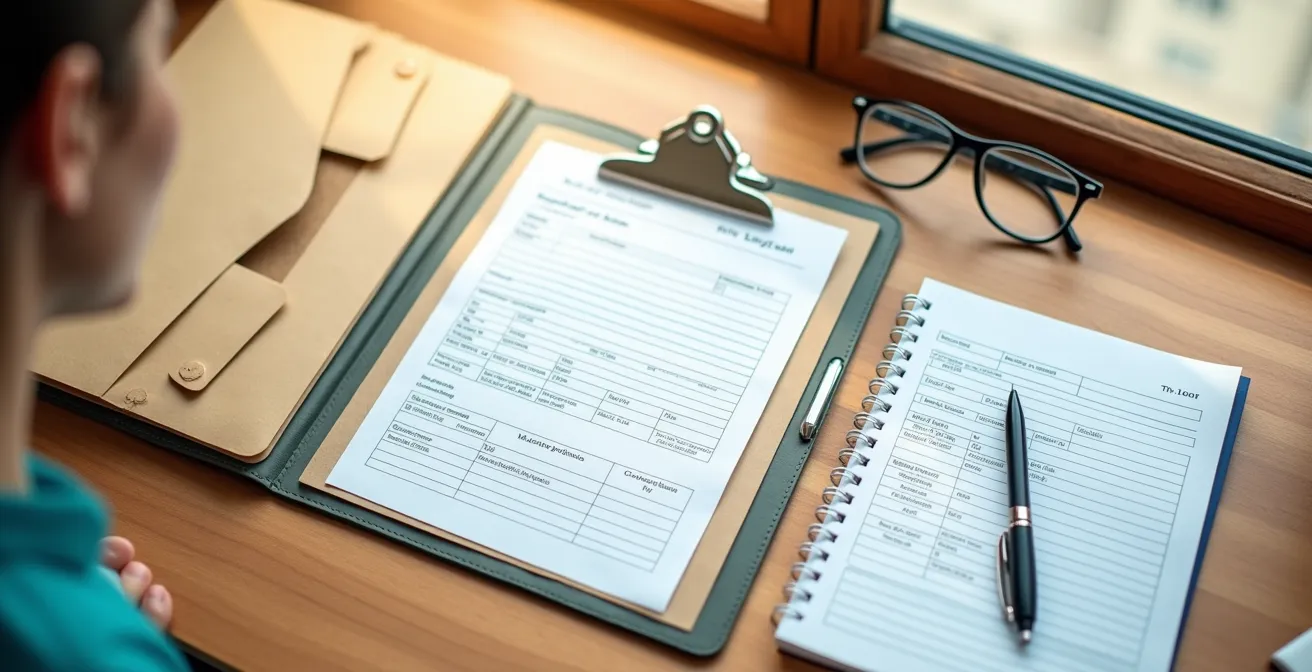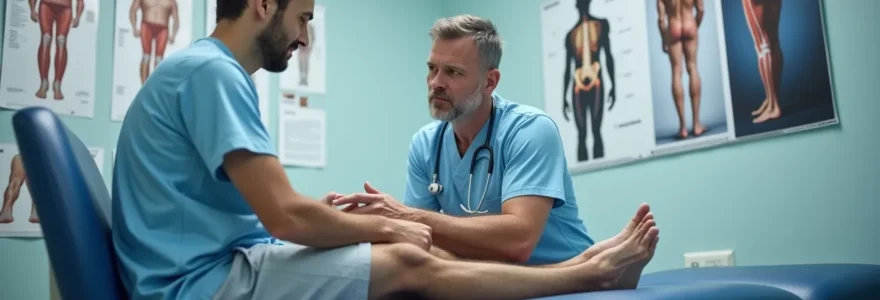That lingering ache in your knee has become a constant, unwelcome companion. While many minor strains resolve on their own, persistent knee pain is more than just an inconvenience; it’s a complex message from your body. The key to preserving long-term joint health isn’t just waiting out the pain, but learning to interpret its specific signals. Understanding when your symptoms have moved beyond the scope of general care is crucial for getting the precise diagnosis and treatment that only a specialist can provide. Consulting an expert like Professor Etienne Cavaignac at the right moment can prevent minor issues from escalating into irreversible damage.
Your Knee’s SOS Signals in 5 Points
- Beyond Duration: “Persistent” pain is defined by its impact on life—interrupting sleep or daily activities—not just by the calendar.
- Mechanical Symptoms: Locking, popping, or a sensation of the knee “giving way” points directly to structural problems requiring specialist evaluation.
- The Specialist’s Toolkit: Orthopaedic surgeons use advanced diagnostics like MRI and arthroscopy to see what a standard X-ray misses.
- Progressive Damage Signs: Chronic swelling, warmth, or redness are indicators of ongoing joint damage that needs immediate attention.
- Early Diagnosis is Key: Timely consultation prevents further deterioration, preserving joint function for the future.
Distinguishing persistent knee pain: When general care isn’t enough
Defining “persistent” pain goes beyond a simple timeframe. It involves evaluating its frequency, intensity, and, most importantly, its impact on your quality of life. Is the pain a dull, constant background noise, or a sharp, debilitating event that disrupts sleep and makes simple tasks like climbing stairs a challenge? While a primary care physician is an excellent first stop, their expertise has limits when faced with complex musculoskeletal issues. For the 15.5% of patients with high-impact chronic knee pain, specialist intervention becomes necessary.
Chronic knee pain is defined as pain that persists or recurs over 3 months. The most common is degenerative osteoarthritis (OA).
– Dr. T. Vanneste, Pain Practice Journal
Certain symptoms are clear indicators of a structural problem that a generalist may not be equipped to diagnose or treat. Red flags include the knee locking or catching, a sensation of instability or “giving way,” significant swelling that doesn’t subside with rest, or an inability to bear your full weight. These are not general aches; they are signs of mechanical failure within the joint that warrants a direct consultation with an orthopaedic specialist for a precise diagnosis.
Key Indicators for orthopedic referral
- Step 1: Assess if pain lasts more than two weeks without improvement
- Step 2: Evaluate for severe swelling or bruising that doesn’t resolve
- Step 3: Check for difficulty bearing weight on the affected knee
- Step 4: Monitor for reduced range of motion in knee movement
- Step 5: Note any popping sounds accompanied by immediate pain
To clarify the distinct roles, a comparison of capabilities is helpful.
| Aspect | Primary Care Provider | Orthopedic Specialist |
|---|---|---|
| Initial Assessment | Basic physical exam and history | Comprehensive musculoskeletal evaluation |
| Diagnostic Tools | Basic X-rays, referrals for advanced imaging | Advanced imaging interpretation, arthroscopy |
| Treatment Options | Medications, basic physical therapy referrals | Specialized injections, surgical interventions |
| Condition Complexity | Minor injuries, general pain management | Complex structural issues, sports injuries |
Specific indicators: Symptoms that clearly signal the need for an orthopaedic knee specialist
The character of your pain provides vital clues. A sharp, localized pain when you twist could suggest a meniscus tear, whereas a deep, aching pain might point toward osteoarthritis. An orthopaedic specialist is trained to analyze these patterns in conjunction with a physical examination to pinpoint underlying conditions like ligament injuries (ACL/MCL) or patellofemoral issues, which often require specific treatment protocols.
What do mechanical knee symptoms mean?
Mechanical symptoms like locking, catching, or instability suggest a structural problem within the knee, such as a torn meniscus or loose cartilage, that is physically obstructing normal joint movement.
Beyond immediate pain, some symptoms signal progressive and potentially irreversible joint damage. These include chronic inflammation that causes persistent swelling, warmth, or redness around the knee. These are signs that the body’s healing response is either failing or actively contributing to joint deterioration. Visible deformities or a change in the knee’s alignment are late-stage indicators that significant damage has already occurred. Early orthopaedic diagnosis is critical to intervene before the joint’s function is permanently compromised.
Observing these warning signs is the first step; the next is taking timely action. The severity of your symptoms dictates the urgency of seeking care. A structured approach helps determine the appropriate response, ensuring you receive the right level of medical attention when you need it most.
This timeline helps put symptoms into perspective, guiding patients on when to seek evaluation.
| Symptom Severity | Timeframe for Action | Recommended Care Level |
|---|---|---|
| Acute trauma with deformity | Immediate | Emergency room |
| Unable to bear weight | Same day | Urgent orthopedic care |
| Significant swelling/warmth | Within 24-48 hours | Orthopedic evaluation |
| Persistent pain >2 weeks | Within 1-2 weeks | Orthopedic consultation |
The orthopaedic surgeon’s distinctive diagnostic and therapeutic arsenal
An orthopaedic surgeon’s evaluation goes far beyond a standard physical exam. They employ advanced diagnostic tools to gain a precise understanding of the joint’s internal structures. While a primary physician might order a basic X-ray to check for fractures, a specialist will utilize high-resolution imaging to assess soft tissues. This includes MRI scans, which boast a 98.3% diagnostic accuracy of MRI for ACL injuries, allowing for detailed visualization of ligaments, tendons, and cartilage.
This ability to differentiate between various causes of knee pain is what sets orthopaedic specialists apart. They can identify subtle biomechanical issues, such as malalignment or instability, that are often missed in a general assessment. This detailed diagnosis is the foundation for a targeted and effective treatment plan. It’s one of the various specialties in surgery that combines diagnostic precision with therapeutic intervention.
Advanced arthroscopic diagnosis revealing hidden pathology
A comprehensive study demonstrated that arthroscopy remains the reference standard for intraarticular abnormalities, with dynamic assessment capabilities that MRI cannot provide. The study showed that arthroscopic probing is especially advantageous in postoperative cases where MRI signal abnormalities may represent either pathology or healing changes, while arthroscopy can definitively distinguish between the two through direct visualization and mechanical testing.
Here is a breakdown of the advanced tools at their disposal.
| Diagnostic Tool | Advantages | Limitations |
|---|---|---|
| MRI | High-resolution imaging, no radiation exposure | Costly, not suitable for patients with metal implants |
| Arthroscopy | Direct visualization, therapeutic capability | Invasive procedure, limited to intraarticular structures |
| Ultrasound | Non-invasive, real-time imaging, cost-effective | Operator-dependent, limited by bone penetration |
| Wearable Sensors | Continuous monitoring, objective data collection | Requires patient compliance, data interpretation challenges |
Based on a precise diagnosis, an orthopaedic surgeon can offer a wide spectrum of interventions, from specialized conservative management to advanced surgical options. This ensures that the treatment is perfectly tailored to the patient’s specific condition, age, and activity level, maximizing the chances of a successful outcome.
Orthopedic surgical intervention spectrum
- Step 1: Arthroscopic procedures – Meniscus repair, ACL reconstruction, cartilage treatment
- Step 2: Joint preservation surgeries – Osteotomy, cartilage restoration techniques
- Step 3: Minimally invasive interventions – Arthroscopic debridement, loose body removal
- Step 4: Advanced biologics – Platelet-rich plasma, stem cell therapy applications
- Step 5: Joint replacement options – Partial or total knee arthroplasty when conservative measures fail
Key Takeaways
- Persistent pain is defined by its negative impact on daily function, not just its duration.
- Mechanical symptoms like locking or giving way are red flags that require immediate specialist evaluation.
- Orthopaedic surgeons use advanced imaging and diagnostic tools to identify issues missed by general practitioners.
- Early and accurate diagnosis is crucial for preventing progressive joint damage and preserving long-term mobility.
Navigating your consultation: Preparing for expert evaluation and treatment planning
To make the most of your specialist appointment, preparation is key. Before you go, take time to articulate your pain history clearly. Think about when the pain started, what activities make it worse or better, and how it limits your daily life. Documenting specific instances of locking, swelling, or instability will provide your surgeon with invaluable information for an accurate diagnosis.
As many patient testimonials suggest, preparing for a specialist appointment can reduce anxiety and empower you to take an active role in your healthcare. Walking in with confidence allows for a more productive discussion about your symptoms and potential treatments.

During the comprehensive evaluation, expect a thorough physical assessment where the surgeon tests your knee’s range of motion, stability, and strength. This hands-on examination, combined with your history and any diagnostic tests, helps build a complete picture of your condition. This is your opportunity to actively participate, so don’t hesitate to ask questions and discuss your goals for recovery to ensure your treatment plan aligns with your lifestyle. When you’re ready, you can discover most consulted specialists to find the right expert for your needs.
A checklist can ensure you cover all necessary bases before your appointment.
| Preparation Category | Key Elements | Why Important |
|---|---|---|
| Medical History | Previous surgeries, medications, allergies | Provides complete health picture for treatment planning |
| Symptom Documentation | Pain patterns, functional limitations, duration | Enables accurate diagnosis and targeted treatment |
| Question Preparation | Treatment options, risks, recovery expectations | Ensures comprehensive understanding and informed decisions |
| Support System | Bring companion, take notes | Improves information retention and emotional support |
Frequently asked questions on orthopaedic surgery
What constitutes a knee emergency requiring immediate attention?
Intense pain right after injury, complete inability to bear weight, visible deformity, or a knee joint locked in position require urgent medical evaluation.
When should mechanical symptoms like clicking worry me?
Locking, popping sounds with pain, or instability that makes the knee feel wobbly often indicate structural damage requiring orthopedic assessment.
How long should I wait before seeing a specialist for knee pain?
Pain persisting more than 2 weeks despite rest and basic care, or any severe symptoms interfering with daily activities warrant specialist evaluation.
